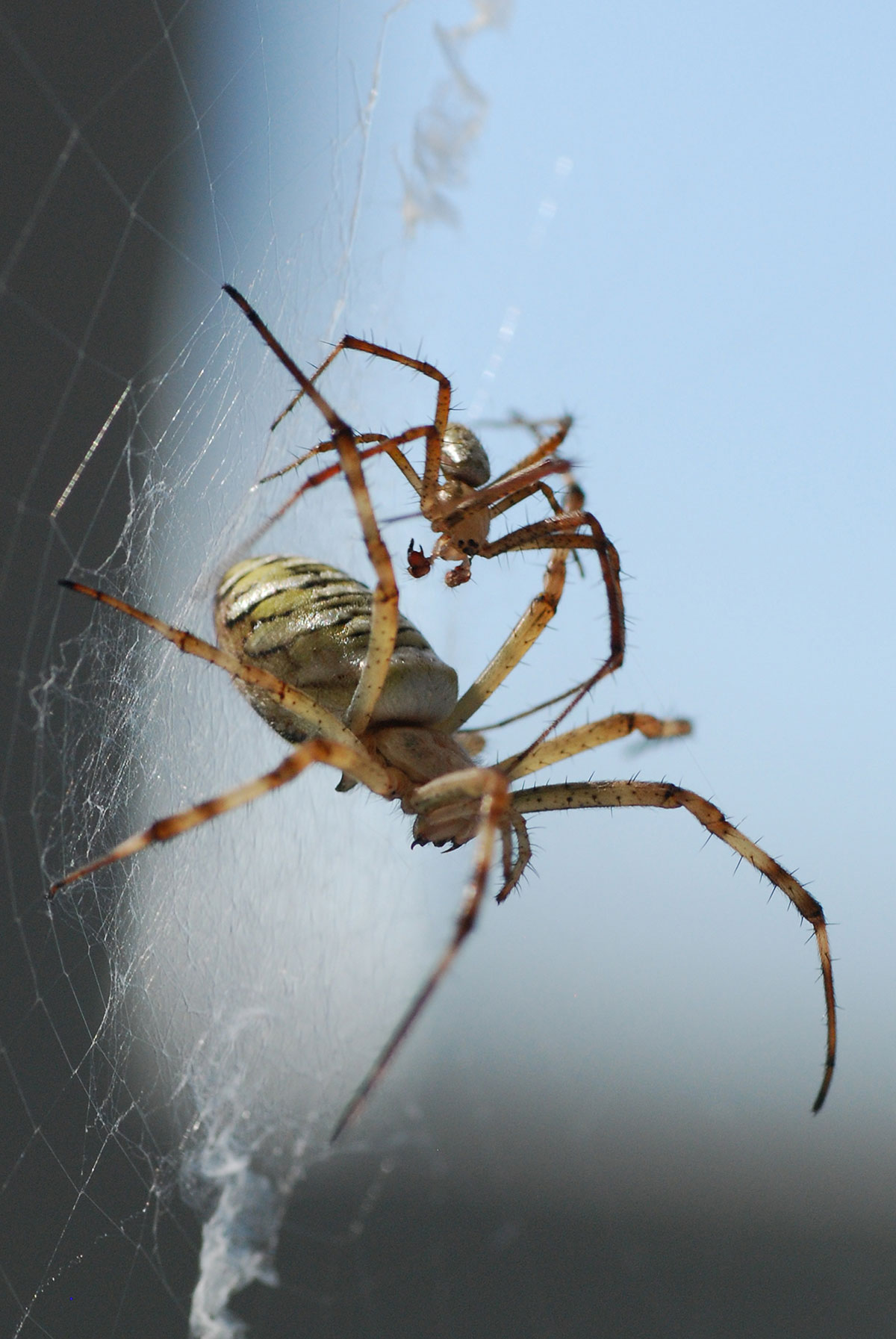Dr. Katharina Weiss
Evolutionary Biology and Ecology
Institute of Biology I (Zoology)
Albert Ludwig University of Freiburg
Hauptstr. 1, 79104 Freiburg, Germany
Tel.: +49 (0)761 203 2531
Email: katharina.weiss@biologie.uni-freiburg.de
Research Interests
My research is concerned with the chemical ecology of orb-weaver spiders. Currently, I focus on the use and function of female sex pheromones. The mating system of many orb-weaver spiders is characterized by a female-biased sexual size dimorphism and post-copulatory sexual cannibalism. In some species, males moreover damage their mating organs during copulation by leafing broken-off pieces in the female’s genital opening that serve as mating plugs to prevent further males from successful insemination. As both sexes have paired genitalia, effective mate plugging limits males and females to a maximum of two copulations. Due to these restricted mating rates, selection should favor males that are not only able to detect females most effectively, but moreover are able to assess the quality (i.e. fecundity and mating status) of their probably sole mate. On the other hand, females likely compete for males that quickly vanish from the population.
I study the role of chemical communication in this context, particularly, the use of volatile pheromones by females and their function in male mate assessment and choice in the orb-weaver genus Argiope. This genus comprises over 80 accepted species that differ markedly in the rate of cannibalism and mate plugging (both ranging between 0 and 100%). Integrating behavioral assays and chemical analyses, I investigate how these differences in mating biology affect costs and benefits of female pheromone signaling and male mate choice.
Moreover, I am interested in the role of other, non-pheromone chemical cues in mate assessment and choice in both males and females, for example in kin-recognition and inbreeding avoidance.
 |  |  |
Argiope bruennichi female (© K. Weiß) | Male Argiope bruennichi (above) courting a female (© K. Weiß) | Female Argiope bruennichi with cannibalized male after copulation (© K. Weiß) |
CV
- since 2022 Scientific Assistant, Evolutionary Biology and Ecology, University of Freiburg (Prof. Dr. O. Niehuis)
- 2019-2022 Postdoc, Behavioral Biology, University of Hamburg, Germany (Prof. Dr. Jutta Schneider)
- 2018-2019 Lecturer for Organismic Biology, University of Regensburg, Germany
- 2013-2017 PhD in Evolutionary Ecology, University of Regensburg (Prof. Dr. Erhard Strohm)
- 2011-2013 Master student in Biology, University of Regensburg
- 2008-2011 Bachelor student in Biology, University of Regensburg
Publications
- Weiss K, Schneider JM (2022). Female sex pheromone emission is affected by body condition but not immune system function in the orb-web spider Argiope bruennichi. Ethology, http://doi.org/10.1111/eth.13280
- Gerbaulet M, Möllerke A, Weiss K, Chinta S,. Schneider JM, Schulz S (2022). Identification of the cuticular and web lipids of the spider Argiope bruennichi. Journal of Chemical Ecology, https://doi.org/10.1007/s10886-021-01338-y
- Weiss K, Schneider JM (2022). Strategic pheromone signalling by mate searching females of the sexually cannibalistic spider Argiope bruennichi. Royal Society Open Science 8: 211806. https://doi.org/10.1098/rsos.211806
- Weiss K, Schneider JM (2021). Family-specific chemical profiles provide potential kin recognition cues in the sexually cannibalistic spider Argiope bruennichi. Biology Letters 17: 1720210260. https://doi.org/10.1098/rsbl.2021.0260
- Weiss K, Ruch J, Zimmer SM & Schneider JM (2020). Does sexual cannibalism secure genetic benefits of polyandry in a size-dimorphic spider? Behavioral Ecology & Sociobiology, 74: 110. https://doi.org/10.1007/s00265-020-02890-5
- Weiss K, Herzner G, Strohm E (2017). Sexual selection and the evolution of male pheromone glands in philanthine wasps (Hymenoptera, Crabronidae). BMC evolutionary biology 17(1), 128. https://doi.org/10.1186/s12862-017-0963-6
- Weiss K, Strohm E, Kaltenpoth M, Herzner G (2015). Comparative morphology of the postpharyngeal gland in the Philanthinae (Hymenoptera, Crabronidae) and the evolution of an antimicrobial brood protection mechanism. BMC evolutionary biology 15(1), 291. https://doi.org/10.1186/s12862-015-0565-0
- Weiss K, Parzefall C, Herzner G (2014). Multifaceted defense against antagonistic microbes in developing offspring of the parasitoid wasp Ampulex compressa (Hymenoptera, Ampulicidae). Plos one 9(6), e98784. https://doi.org/10.1371/journal.pone.0098784
- Herzner G, Kaltenpoth M, Poettinger T, Weiss K, Koedam D, Kroiss J, Strohm E (2013). Morphology, chemistry and function of the postpharyngeal gland in the South American digger wasps Trachypus boharti and Trachypus elongatus. Plos one 8(12), e82780. https://doi.org/10.1371/journal.pone.0082780


